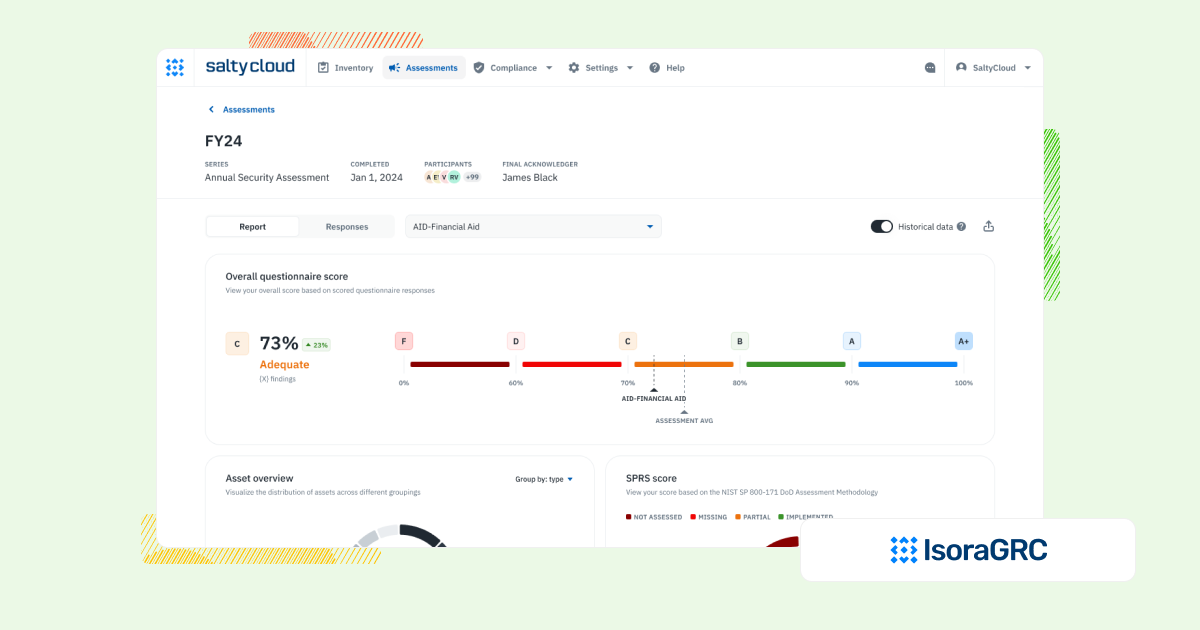
Every security team needs a practical, scalable way to manage IT risk—not just an affordable option that sacrifices capability.
Platforms like Eramba and SimpleRisk offer free or budget-friendly tools that may seem like a good starting point.
But lightweight tools may look simple, but they lack the structure and scalability teams need to grow a real risk program.
Isora GRC offers a unique solution. It’s purpose-built for security teams who need to run assessments, manage inventories, and track risks—offering a comprehensive, flexible solution that grows with your needs
Let’s examine this more closely.
Choosing the Right Platform for IT Risk Management
Eramba and SimpleRisk provide basic capabilities for teams just starting out—like simple risk registers and lightweight compliance workflows. But as organizations grow and their risk programs mature, these tools often become hard to scale. They may require manual upkeep, lack integrations, or fail to support cross-functional collaboration.
Isora GRC offers a clear upgrade path. It delivers structured, scalable workflows for internal and external risk assessments, asset and vendor tracking, exception management, and audit-ready reporting. It’s fast to implement, easy to adopt, and built to grow with your program—without requiring expensive customization or long-term support contracts.
The Workflow That Matters: Managing IT Risks and Compliance
As risk programs mature, manual spreadsheets and disconnected processes become unmanageable. Teams need reliable, repeatable workflows that support visibility, accountability, and continuous improvement.
Isora GRC provides that structure. It supports recurring assessments, links risks to assets or vendors, and allows teams to comment, assign, and resolve issues in a single system. Unlike entry-level tools, Isora enables real collaboration and real-time insight into your risk landscape.
How Each Platform Supports IT Risk Management Workflows
| Workflow Area | Eramba | SimpleRisk | Isora GRC |
| Assessment Management | Eramba gives basic tools for assessments. Many users say the system feels shallow and hard to adjust. Custom options stay limited, and setting up automation takes time. This often leads to more manual work and slower progress. | SimpleRisk gives basic tools for assessments. Custom options stay limited. Adjusting forms for specific needs can feel hard. No strong automation means more manual steps for teams. | Centralized, intuitive assessment dashboard across business units, vendors, and assets. Built specifically for security teams. |
| Questionnaire Delivery & Completion | The survey tool in Eramba feels too simple. It lacks strong options for detailed forms. Users find the layout confusing and hard to use. Building and managing surveys becomes a slow task. Connecting with other tools for smooth data flow also needs improvement. | The system sends surveys in a simple way. Still, it lacks depth for detailed setups. Users who need strong links to other tools or more control may feel limited. | Customizable and prebuilt questionnaires for frameworks like NIST, ISO, GLBA, HIPAA, and more. Designed for internal and external collaboration. |
| Inventory Tracking | Tracking assets with Eramba feels limited. It misses helpful features needed by bigger teams. Managing many assets gets harder with no strong links to outside systems. This weakens support for teams with mixed tools and large inventories. | Inventory tracking in SimpleRisk feels weak. Teams with lots of assets may need stronger features to stay organized. | Centralized tracking of assets, vendors, and organizational units with integration support for existing data sources. |
| Risk Register & Exception Management | Eramba’s risk register stays basic with little room to adjust. Handling exceptions also needs a lot of manual setup. The system can’t handle complex flows, which hurts teams with detailed risk needs. | SimpleRisk includes a risk log, but it doesn’t handle complex flows well. Custom setup stays limited, and exception tracking may not work well for teams with many risk types. | Flexible, collaborative risk register with scoring, status, evidence, and ownership tied directly to assessments. Exception management is built-in and intuitive—no extra modules or configuration required. |
| Scoring, Reporting & Risk Visualization | Scoring and reporting tools work but lack power. Many users say reports feel limited and hard to use. Visual risk data stays weak, and creating useful reports often needs tech help. | Scoring and reports feel basic. Users looking for deep insights or flexible charts may run into limits. The system lacks strong tools for data display. | Automated scorecards, risk maps, and executive-friendly reports with actionable insights—no manual config required. |
| Collaboration & User Experience | The layout feels old and confusing. Teamwork tools don’t work well together. Sharing info takes effort, and group work feels clunky. A cleaner, simpler design could help teams move faster. | The layout works but feels less smooth than others. Teamwork tools stay simple. Some users may need training to use everything well. | WCAG-compliant, award-nominated interface with built-in commenting, team workflows, and fast onboarding. |
| Implementation & Setup | Setting up Eramba takes time. Users often need to adjust many things before use. While the price feels low, the setup feels long and harder to manage. | Setting up SimpleRisk feels easy for simple needs. For complex setups, the process may feel tight due to fewer options to adjust things. | No-code setup in days or weeks. Minimal IT lift required. Designed to go live quickly across teams and vendors. |
What Sets Isora GRC Apart?

Isora GRC was purpose-built for information security teams—designed to support the real workflows behind risk and compliance, not just generate reports. While legacy GRC platforms require months of configuration and rigid processes, Isora takes a modern, scalable approach:
- Purpose-built for security and third-party risk teams
- No extra modules or cross-department bloat—just the workflows that matter.
- Easy for anyone to use
- Clean UI, no complex training, and built to drive adoption across the org.
- Streamlined for action, not just documentation
- Assessments, questionnaires, inventories, risk tracking, and reporting—all in one place.
- Fast, no-code implementation
- Go live in weeks, not quarters, with minimal IT lift.
- Scales with your program
- Whether you’re running a lean risk function or supporting a large institution, Isora grows with you—without getting in the way.
Who Each Platform Is Best For
| Platform | Who It’s For |
| Eramba | Security folks who like open-source tools and don’t mind doing setup themselves. Not great for busy teams. |
| SimpleRisk | DIY risk management on a tight budget. Works for simple needs, but gets messy when things grow. |
| Isora GRC | Security teams that need a scalable, usable IT risk management program across their organization. |
What Our Customers Say About Isora GRC
Security teams at top institutions are using Isora GRC to replace legacy tools and manual processes with intuitive workflows and actionable insight.
“Moving from manual processes to using Isora was a breath of fresh air. What used to take months is now automated, reliable, and defensible. Isora saves us significant time while delivering accurate insights that improve decision-making.”
Jessica Sandy, IT GRC Manager, The University of Chicago
“Isora has been essential in helping us meet our University of California cybersecurity requirements across a decentralized campus. Automating assessment data collection and reporting has given us clear visibility into unit-level risks, enabling us to prioritize resources effectively and address gaps with confidence.”
Allison Henry, CISO, The University of California, Berkeley
FAQs
What’s the difference between Eramba, SimpleRisk, and Isora GRC?
Eramba and SimpleRisk are open-source or low-cost GRC tools with basic risk and compliance functionality. Isora GRC offers a more robust, enterprise-ready platform for managing IT and third-party risk through structured assessments, inventories, exception tracking, and collaborative workflows.
Are Eramba and SimpleRisk considered full-featured GRC platforms?
They offer essential capabilities but lack the usability, scalability, and workflow depth needed for larger organizations. Teams often outgrow these tools as risk programs mature. Isora GRC provides the structure and flexibility required for growth and adoption across departments.
Does Isora GRC replace tools like Eramba or SimpleRisk?
Yes. Isora GRC offers a more complete platform that includes internal and vendor assessments, inventory management, exception handling, and real-time risk tracking—all with a modern user experience and faster time to value.
Which platform is better for scaling IT and vendor risk programs?
Isora GRC. It’s designed for teams that need to go beyond spreadsheets and lightweight tools—supporting scalable, repeatable workflows for both internal and third-party risk assessments.
Can Isora GRC be used alongside Eramba or SimpleRisk?
Technically yes, but most teams move to Isora GRC when their needs surpass the capabilities of entry-level tools. It consolidates risk workflows into a single, usable system with stronger adoption across stakeholders.
What should I look for when upgrading from open-source GRC tools?
Look for ease of use, structured workflows, cross-team collaboration, and support for both internal and vendor risk. Isora GRC provides these out of the box, making it a strong next step for teams looking to mature their risk programs.



















 Other Relevant Content
Other Relevant Content